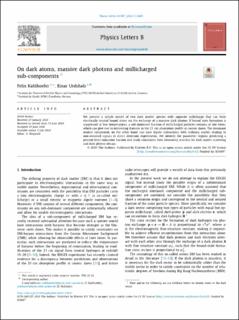| dc.contributor.author | Kahlhoefer, Felix | |
| dc.contributor.author | Urdshals, Einar | |
| dc.date.accessioned | 2022-11-21T10:05:45Z | |
| dc.date.available | 2022-11-21T10:05:45Z | |
| dc.date.created | 2021-02-18T16:22:15Z | |
| dc.date.issued | 2020 | |
| dc.identifier.citation | Physics Letters B. 2020, 807, . | en_US |
| dc.identifier.issn | 0370-2693 | |
| dc.identifier.uri | https://hdl.handle.net/11250/3033091 | |
| dc.description.abstract | We present a simple model of two dark matter species with opposite millicharge that can form electrically neutral bound states via the exchange of a massive dark photon. If bound state formation is suppressed at low temperatures, a sub-dominant fraction of millicharged particles remains at late times, which can give rise to interesting features in the 21 cm absorption profile at cosmic dawn. The dominant neutral component, on the other hand, can have dipole interactions with ordinary matter, leading to non-standard signals in direct detection experiments. We identify the parameter regions predicting a percent-level ionisation fraction and study constraints from laboratory searches for dark matter scattering and dark photon decays. | en_US |
| dc.language.iso | eng | en_US |
| dc.publisher | Elsevier Science | en_US |
| dc.rights | Navngivelse 4.0 Internasjonal | * |
| dc.rights.uri | http://creativecommons.org/licenses/by/4.0/deed.no | * |
| dc.title | On dark atoms, massive dark photons and millicharged sub-components | en_US |
| dc.title.alternative | On dark atoms, massive dark photons and millicharged sub-components | en_US |
| dc.type | Peer reviewed | en_US |
| dc.type | Journal article | en_US |
| dc.description.version | publishedVersion | en_US |
| dc.source.pagenumber | 9 | en_US |
| dc.source.volume | 807 | en_US |
| dc.source.journal | Physics Letters B | en_US |
| dc.identifier.doi | 10.1016/j.physletb.2020.135601 | |
| dc.identifier.cristin | 1891474 | |
| cristin.ispublished | true | |
| cristin.fulltext | original | |
| cristin.qualitycode | 2 | |

